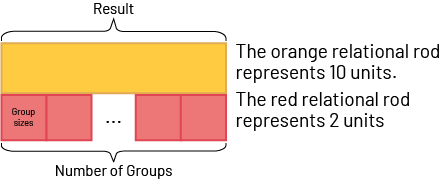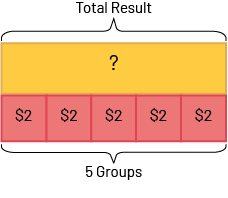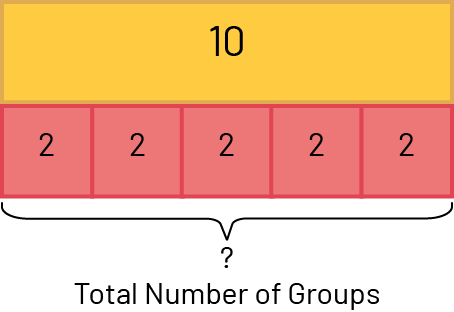B2.5 Represent and solve equal-group problems where the total number of elements is no more than 10, including problems in which each group is a half, using tools and drawings.
Skill: Representing and Solving Equal-Group Problems
Modelling and Counting
Initially, students usually need to model the facts using their fingers or concrete materials. In the case of multiplication, students model these operations with concrete materials, tallies, or drawings that represent objects organized into groups. They often count these objects to find an answer. Students use these models to find a solution to problems such as "Three bowls contain apples. Each bowl contains 5 apples. How many apples are there in total?"
Students will be able to draw the bowls of apples and count the apples drawn to determine the total number of apples.
Source: translated from Guide d’enseignement efficace des mathématiques de la maternelle à la 6e année, Fascicule 5, p. 12.
To understand multiplication, students need to make connections to other mathematical concepts. In particular, students need to know that multiplication can be interpreted as repeated addition. Students also need to be able to create groups or sets of equal size.
Source: translated from Guide d’enseignement efficace des mathématiques de la maternelle à la 6e année, Fascicule 5, p. 8.
Effect of Operations
Each operation has an effect on the quantities involved. Depending on the operation, certain quantities increase or decrease. They may increase or decrease by a lot or a little. Tracking the effect of operations on numbers allows students to make connections between operations and to anticipate the outcome of an operation.
For example, we can compare the effect produced by addition on whole numbers with that produced by multiplication on whole numbers. Compared to multiplication, addition increases a number by a small amount. When the number 2 is multiplied by 8, the result is 16, whereas if you add 8, the result is only 10. People with good operational sense recognize the effect of operations on whole numbers, but care must be taken when generalizing, as operations on decimal numbers or fractions may have different effects than operations on whole numbers. In some cases, the effect may even be the opposite. For example, if you multiply one whole number by another whole number, the product is larger than both factors (for example, if you multiply 3 by 6, the product 18 is larger than 6 and 3), whereas if you multiply a proper fraction by a whole number, the product is smaller than one of the two factors (for example, if you multiply one half by 6, the product 3 is smaller than 6).
Source: translated from Guide d’enseignement efficace des mathématiques de la 4e à la 6e année, Numération et sens du nombre, Fascicule 1, Nombres naturels, p. 90.
Problems Related to Multiplication and Division
Students develop an understanding of multiplication and division and the relationships between numbers by solving problems. The types of equal group problems presented below with examples can help students see the connections between basic number facts about multiplication and division in a variety of ways. Using problems to introduce basic number facts compels students to reason their way to solutions and thus helps develop a better sense of operations.
The sample problems below contain one-digit numbers. The structures of the three types of problems also lend themselves to multi-digit numbers. The problems are represented using relational rods. In Grade 1, students will work with problems where the whole is unknown or the number of groups is unknown. They are always given the size of the groups.
Equal-Group Problems

- Equal Groups: Total Unknown (Multiplication)
Julie bought 5 books for her classmates. Each book cost her $2. How much money did Julie spend on all these books?

- Equal groups: Number of Groups Unknown
Julie has bought 10 books for her classmates and is making gift bags. She puts 2 books in each bag. How many gift bags did Julie use?

Source: translated from Guide d’enseignement efficace des mathématiques de la maternelle à la 6e année, Fascicule 5, p. 10-11.
Knowledge: Equal Group Problems
With equal group problems, a group of a given size is repeated a certain number of times to create a total. Sometimes the size of each group is unknown, sometimes the number of groups is unknown, and sometimes the total is unknown.
Note: In Grade 1, students are always given the size of the equal groups and they determine either the number of equal groups or the total needed (not to exceed 10).
